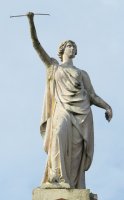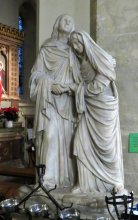Kirk dynasty of sculptors
Three generations of the Kirk family, mostly of Dublin but originally from Scotland, were sculptors, and although most of their public works are in the Republic of Ireland, and thus outside the purview of this website, they are of interest to these pages as the statue of Justice atop the Belfast County Court, Crumlin Road, is by one of them, as well as the odd piece in England.
.
Justice figure, Crumlin Road Coart, Belfast.
Thomas Kirk (1777-1845)
Thomas Kirk was the patriarch of the family, born in Newry, County Down, but studying sculpture and later settling in Dublin. He worked initially on decorative architecture, before setting up his own studio, in Jervis Street, Dublin, where he developed a considerable reputation for portrait sculpture, and through winning the competition for a statue of Nelson for that city – alas destroyed in the 20th Century. He was a founder member of the Royal Hibernian Academy in 1822, and exhibited a few pieces at the Royal Academy – four busts in 1825, and four further works in 1837, 1839 (two), and 1845. Alongside various public works in Dublin, and numerous busts in the possession of various institutions there, Thomas Kirk has a few works in in England too, most notably Sidney Smith in the Maritime Museum in Greenwich, London. Among his numerous offspring were three who trained under him and worked as sculptors – sons Joseph Robinson Kirk and William Boyton Kirk, one of whom made our Crumlin Road statue, and daughter Eliza Kirk, and his grandson Thomas Stewart Kirk took the dynasty to the third generation.
Joseph Robinson Kirk (1821-1894)
The Irish sculptor Joseph Kirk studied under his father and at the Dublin Society schools, becoming known for his portrait busts, but had too some number of Classical and allegorical figures. He exhibited 8 pieces at the Royal Academy from 1846 through to 1862, including Classical and religious groups and portraits, but mostly exhibited at the Royal Hibernian Academy, of which he was a member from 1854 (Associate from 1845), later becoming Professor of sculpture, along with other posts including a governor of the National Gallery of Ireland. In Northern Ireland are his statue and memorial to Captain Crozier, Banbridge, County Down, and the 3rd Marquis of Downshire on a tall column in Hillsborough (not to be confused with the statue of the 4th Marquis there on a tall plinth, by S.F. Lynn). The Justice statue atop the Belfast County Court, Crumlin Road, is given to him by an information board in front of the building, but Strickland’s Dictionary of Irish artists, our best source from which many other records are derived, gives it to his brother William, noted below. Regardless, Joseph Kirk was predominantly a Dublin artist, and most of his public work is in the Republic of Ireland. His chief works include four massive seated allegorical figures on the Trinity College Dublin building, and as part of his main oeuvre of portrait pieces, he had some small production of monuments, notably to Thomas Abbott in Christ Church Dublin, with a full figure of a child. His work had a public appeal, with pieces bought for, and reproduced in miniature by the Royal Irish Art Union.
Joseph Kirk’s figure pieces, from the small number I am acquainted with, are conventional in pose, tending to a Greek Classical muscularity with a slight heaviness to the arms and necks of his female figures. His drapery tends to fairly simple, large folds, to give an effective and dramatic contrast of light on shade on his architectural figures at a distance. The Crozier monument has the statue in modern dress, with a large swept-back cloak, and is perhaps less successful in this respect.
Joseph Kirk visited his brother William (see below) in London whilst the latter was a clergyman at St Mary of the Angels, Bayswater, and presented to the Church a group of St Mary and St John at the Crucifixion which he had made some years earlier, pictured below. It is rather a contrast to his secular work, and is notable for the Virgin's pose, clasping her hands round the forearm of St John.
St Mary and St Joseph, 1851.
William Boyton Kirk (1824–1900)
William Kirk followed in the footsteps of his elder brother, studying under his father and at the Dublin Society school, and being elected Associate of the RHA in 1850. As noted above, Strickland ascribes to him the Belfast County Court Justice, made about this time, and between 1848 and 1857 he exhibited half a dozen pieces at the Royal Academy, two of which were Shakespearean and two more, ideal figures (the other two were portrait heads), and some works at the RHA. He worked as a modeller in Parian ware for a Worcester porcelain works, illustrated an edition of Midsummer Night’s Dream by Shakespeare, and in 1860 settled finally in England, changing his profession to that of a clergyman.
Eliza Kirk (b.1812)
Also trained under her father Thomas Kirk, she made miniature portrait busts, and sentimental allegorical groups such as Maternal Love, and Child and Butterfly. She exhibited as late as 1856, but then disappears; and I have not seen any of her work.
Thomas Stewart Kirk (1848-1879)
Joseph Kirk also brought up a nephew (son of another sister, Mary), the short-lived Thomas Stewart Kirk (1848-1879), another, rather minor portrait sculptor, who thus took the profession into the third generation. He had been born in America, and was back there by the time of his death.

